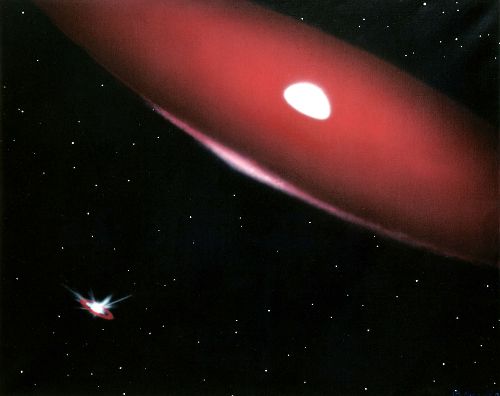
|
Credit & Copyright: William Pounds
Explanation:
It's clear who is the biggest star in
this binary system.
Based on recent results,
this artist's vision of the double star
Phi Persei, 720 light years away,
shows a bright, rapidly rotating massive star
surrounded by a
disk of gas.
A small
companion star orbits 100 million miles away.
The bigger star is presently about 9 times more massive
than the small one ...
but it wasn't always this way.
Ten million years ago the small companion was actually the most massive
star in the system and
because of its greater mass evolved into a giant star more quickly.
After losing its swollen outer layers to the now massive star,
all that remains is a stripped down,
intensely hot core of about 1 solar mass.
In another ten million years, the roles may reverse as the
now massive star swells into its own giant phase "returning" mass to
its companion.
Will these stars end their lives as
white dwarfs or
supernovae?
Astronomers consider the ultimate fate of such
mass-exchanging, interacting
binary systems an open question and a challenge for present
theories of stellar evolution.
|
January February March April May June July August September October November December |
| ||||||||||||||||||||||||||||||||||||||||||||||||
NASA Web Site Statements, Warnings, and Disclaimers
NASA Official: Jay Norris. Specific rights apply.
A service of: LHEA at NASA / GSFC
& Michigan Tech. U.
Based on Astronomy Picture
Of the Day
Publications with keywords: stellar evolution - binary star
Publications with words: stellar evolution - binary star
See also:
